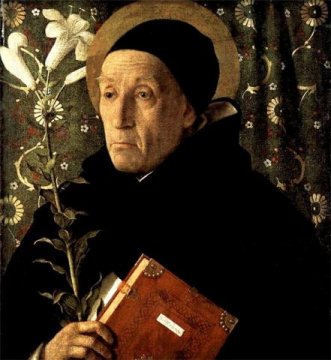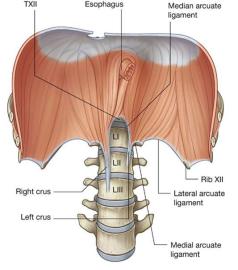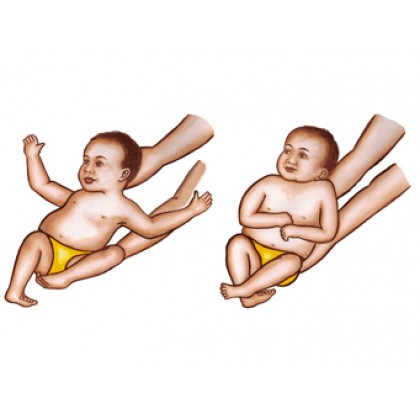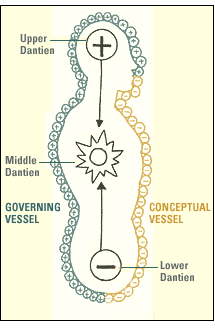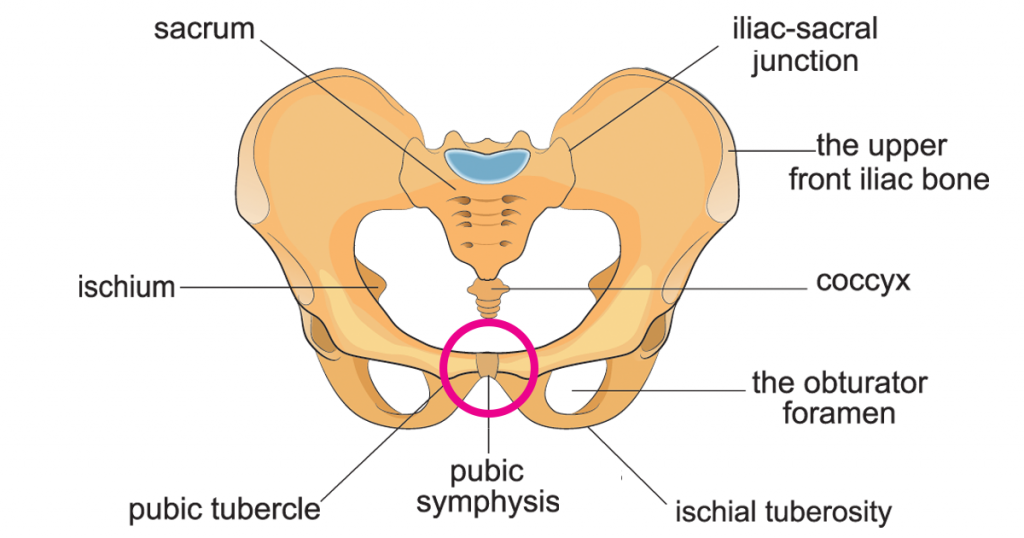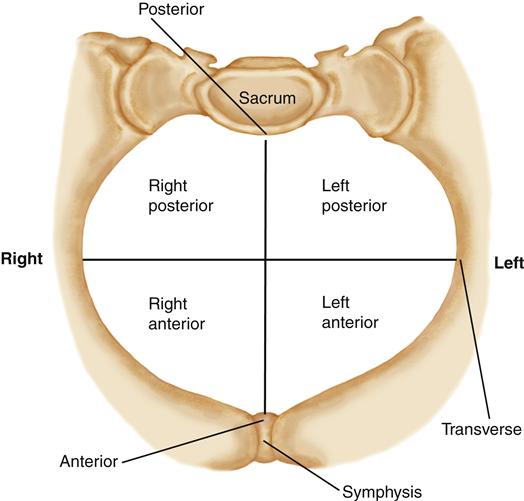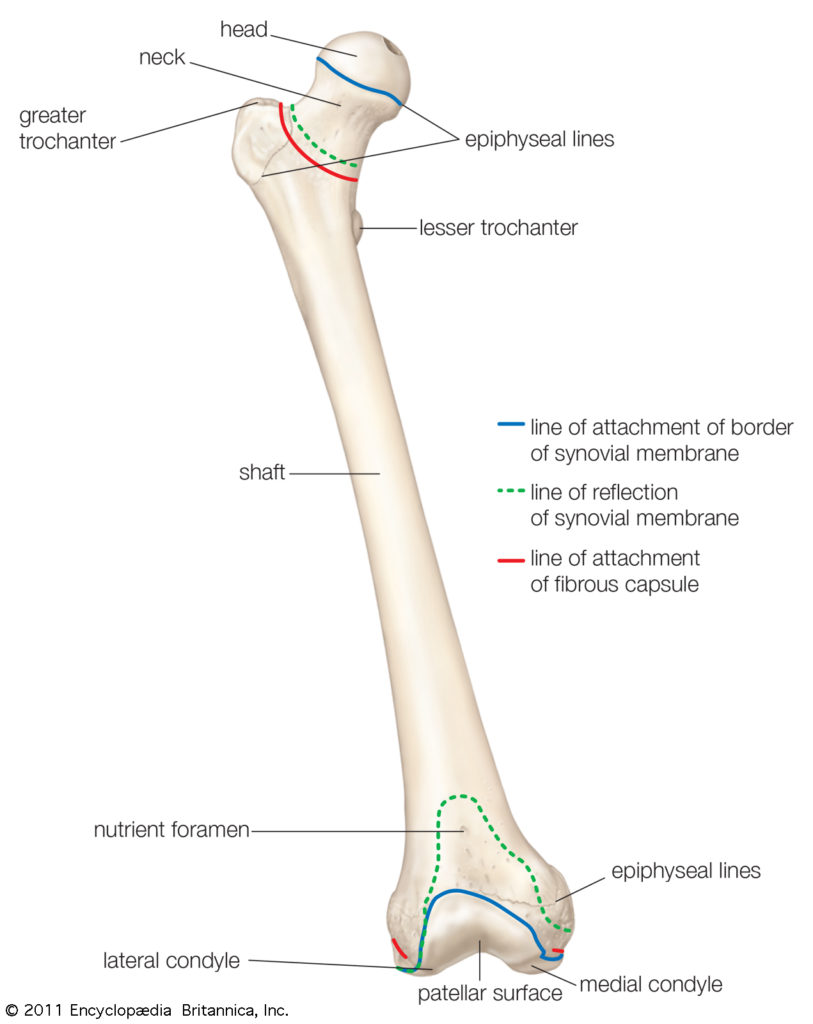Introduction
In the previous post, we introduced the seven karmic lessons of life and some explorations of these using the microcosmic orbit and some anatomical references on the front and back body. Keep working with whichever of the lessons is relevant to you in your life right now. Our next exploration of these lessons will come from the interior perspective of the yin organs, but that will come in a future post as first we will need some preliminary work linking Yoga, Taoism and the Organ systems to help keep us on track.
Remember that our karmic lessons pertain to every moment of our lives. Fall of 2020 is going to be a turbulent and challenging time and we all need to remain grounded, heart centered and clear, no matter what arises. Keep resting in Being and allow Life to flow through you, as best you can. Stay safe, support small businesses, be kind to one another, and do what you can to help get out the vote. Don’t waste energy worrying about things you have no control over. Keep the the loving open heart channeling into the human energy field and we will get through this.
Before we continue, I have to pass on Bonnie Bainbridge Cohen’s wisdom, as presented in the introduction to her Fall 2020 series of classes on the Spine, offering us a clear vision of inner dimensions of our somatic explorations. She is the voice of Somatic Spiritual Awakening.
CELLULAR CONSCIOUSNESS
Each cell in our body has living intelligence. It is capable of knowing itself, initiating action, and communicating with all other cells. The individual cell and the community of cells (tissue, organ, body) exist as separate entities and as one whole at the same moment. Cellular consciousness is a state in which all cells have equal opportunity for expression, 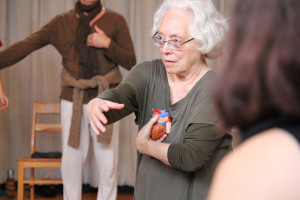 receptivity, and cooperation. Attuning ourselves to our cellular consciousness brings us to a place in which we can find the ground from which flows the intricate manifestations of our physical, psychological, and spiritual being.
receptivity, and cooperation. Attuning ourselves to our cellular consciousness brings us to a place in which we can find the ground from which flows the intricate manifestations of our physical, psychological, and spiritual being.
EMBODIMENT
Embodiment emerges from our cells’ awareness of themselves. It is a direct experience. There are no intermediate steps or translations. There is no guide, no witness – just the fully known consciousness of the experienced moment initiated from the cells. Here, the brain is the last to know. The process of embodiment is a being process, not a doing process. It is an awareness process, not a thinking process. There is complete knowing and peaceful comprehension. Out of this embodiment process emerges feeling, sensing, thinking, witnessing, understanding, compassion. The source of this process is free; it is love.
**************
Patanjali and Lao Tzu: The Meeting of Yoga and Taoist Practices
In general, the cellular consciousness referred to by Bonnie is unconscious in most of us. The journey is to awaken to this always present flow of energy and information and then allow any and all sense of separateness to dissolve into this fundamental embodied 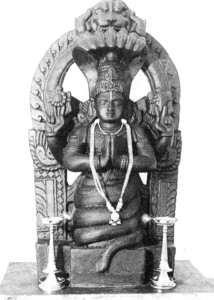 aliveness. Patanjali, in the beginning of the Sadhana Pada, the second chapter of the Yoga Sutras entitled “On Practice”, lists three essential practices known together as Kriya Yoga, that guide our journey. They begin sequentially, but then intertwine into an evolving spiral of awakening and integration.
aliveness. Patanjali, in the beginning of the Sadhana Pada, the second chapter of the Yoga Sutras entitled “On Practice”, lists three essential practices known together as Kriya Yoga, that guide our journey. They begin sequentially, but then intertwine into an evolving spiral of awakening and integration.
Taoism has many parallels that take us right into the organ systems. Chinese Medicine is process based. Rather than referring to anatomical structures such as kidneys, it refers to organ 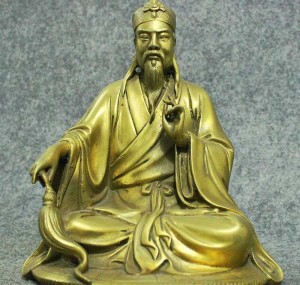 systems, including all metabolic and integrative processes associated with the organs and their related hormones. Organ systems also have a subtle psycho-spiritual component unseen in Western medicine.
systems, including all metabolic and integrative processes associated with the organs and their related hormones. Organ systems also have a subtle psycho-spiritual component unseen in Western medicine.
The first essential practice is discipline or tapas in Sanskrit. Without discipline, there is no practice, or no ability to sustain practice when difficulty arises, and this is true no matter what the subject matter, no matter what level of experience we may have. This is very true in spiritual practice, and Patanjali introduces the more advanced expressions of discipline, abhyasa and vairagya, in chapter I, the Samadhi Pada, sutras I-12 – 16. Abhyasa is the constant directing of our energies to create layers and levels of stability. This includes grounding in the world of form, through bones, fluids and mind, and also stabilizing our awakening in the formless. Vairagya is the constant directing of our energies away from habits and patterns that perpetuate unconscious delusion and suffering, and transforming them towards into patterns that are stabilizing and Awakening. Abhyasa and vairagya are tow sides of the same coin
Discipline is a form of will power, and In Taoism, Will is one of the five Shen or Spirits and resides in the Kidney Organ System. In Taoism, will has a yin and yang component. The Yang Will involves both the day to day and major life decisions and its active and dynamic energy helps us stay focused on the tasks at hand. Yin Will is quite different. Ted Kaptchuk, in his book on Chinese Medicine, “The Web That Has No Weaver”, describes it this way.
“Yin Will is the other side of Will. It is the deeper encounter with the inexorable and ultimate destiny that already exists hidden in the undifferentiated seed. It is the recognition that the deepest force requires no effort. The Yin Will is elusive, almost intangible. It is noticed in stillness. It has a quality of irreducible mystery. The Yin Will is about the inevitable, about a direction we each move toward that can only be seen when we turn around and look at how we have developed through time. It is about fate and destiny. It is about the unknown and depth.
Recognition of Yin Will allows for the creation of the virtue of Wisdom. This Wisdom is not about knowing things. In fact, it is more about being deeply connected to the unknown. Wisdom is a recognition of the fact that life is an intertwining of known and unknown.”
We will soon see how Yin Will links up with the third practice, but Yang Will will leads to the second practice of Kriya Yoga, svadhyaya, Self-study or Self inquiry. Yang Will involves choices (when and how do we apply discipline) and for this we need to cultivate discriminating intelligence. The first stage of Self study is the examining the rules and laws that govern the world of form (known as Prakriti in the Yoga Sutras) and the nature of our own habits and behaviors. In learning what aspects of our lives and mental activities to cultivate and what to eliminate, we discover a discriminating intelligence that can be awakened and refined to guide us in our day to day and long term decision making. This is very true on the collective level as well and is a life long endeavor also as our habits have layers and layers going back through our ancestors.
In Taoism, this discriminative intelligence is another of the five Spirits and resides in the Spleen-Pancreas Organ System. The Spleen-Pancreas, in Chinese Medicine, extracts the ‘pure from the impure’. On a biological level, in the digestive process, the nutrients and anything else that is beneficial are separated and absorbed into the blood stream, while the rest is sent along for elimination. The blood is also filtered and monitored for potential infectious agents, engaging the immune system. The Spleen-Pancreas also discriminates at the psychological and spiritual level, helping us make intelligent descisions about all aspects of our lives. This processing is analogous to the Samana Vayu in Yoga.
The second stage of svadyaya is inquiry into Who, or what am I. What is this “I – me – mine” mind set that drives my behavior? What is change? What is stillness? Can I discover my innate True Nature, as and in the Stillness at the core of my heart? Self study includes reading sacred scriptures that discuss this question, such as the Tao Te Ching, the Bhagavad Gita, The Upanishads, the many Buddhist Sutras, and mystical poetry. It is about Being and not doing, as Bonnie described above. In the Yoga Sutras II-26 – 27, Patanjali discusses this deeper dimension of discriminating wisdom. In Taoism, is the recognition of the small Shen, the ruler of the Five Spirits that resides in the Heart Organ System and the fullness (purna) of the Big Shen, one of the Three Treasures.
The third practice, Ishvara Pranidhana, is the dissolving of the egoic structures into Being. It is allowing Life in its Wholeness to flow though you effortlessly. This is Yin Will in action. Egoic structures are energetic habits of thought and belief that perpetuate the illusion of ‘separateness’ that causes so much suffering. The energy held in these patterns can be transformed by first seeing them for what they are and then exposing them to the direct realization of True Nature, where they dissolve like a wave returning to the vast ocean. Because of karmic momentum, the egoic patterns will keep coming back. But if we can recognize them as just waves, transient phenomena arising out of the depths of True Nature, and stop feeding them by resisting or giving into them, eventually the karmic momentum resolves back into the Source and they come to an end.
The fact that in Kriya Yoga Ishvara Pranidhana comes after Self Study is crucial. It is easy to ‘let go’ into unconscious habits and believe that the ego is letting go. This is one of the great tricks of the ego. You can see obvious examples in spiritual teachers who have had a powerful ‘waking up’ experience, but haven’t done enough ‘growing up’ emotionally. The results are not pretty. The cultivation of discriminating wisdom helps keep all of us from our own self delusion.
Ishvara is a Sanskrit word that points to Divinity as manifest in the multiplicity of forms in the Universe. It is infinite creativity in action. As my Vedanta teacher Swami Dayananda used to say, “What is, is Ishvara”. There are many layers to the practice of Ishvara Prahidhana as demonstrated by Patanjali using this expression in three different sections of the Yoga Sutras. In the first chapter, sutras I-23 – I-29 are all devoted to Isvara. And all three of the Kriya Yoga practices are included as part of the Niyamas, one of the eight limbs of Ashtanga Yoga described later on.
There are two more Yin Organ systems associated with the Five Spirits that we need to consider and they are linked together in a quite interesting Yin-Yang way. The Lung Organ System is associated with the Spirit known as Po, the corporeal soul. Po is the denser yin expression of embodiment, associated with the five elements, concerned solely with this body and this incarnation, and returns to the Earth at death. There are seven Po, related on the physical plane to the seven sensory openings: two eyes, two ears, two nostrils and the mouth. The are also related to the seven Karmic lessons of life discussed in the previous post.
The Liver Organ System is the home of Po’s yang counterpart Hun, or the non-corporeal soul. The Hun is lighter, more expansive and more subtle than the denser Po. It is the aspect of spirit that has no attachment to the physical body and at death leaves the body to dissolve into more ethereal realms of existence. It is the Hun that is the vehicle for shamanic journeying. There are three Hun, sometimes referred to as three spirits or energy fields of differing densities surrounding the physical body (the 7 Po). The ethereal is the densest, the light and finally the true spiritual plane. Taoist master Jeffrey Yuen also teaches that Po is related to space and Hun to time.
*****************************
An Overview of our Inner Anatomy
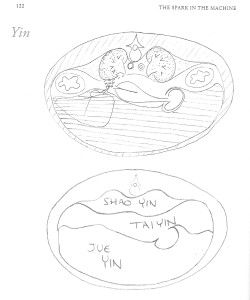 Let the Kriya Yoga of ‘Discipline/Self Study/Letting Go’ guide our explorations as we use breathing, the leverage of different postures and micro-movements to bring attention/conscious awareness to some of these inner spaces of the body, the organs that embryologically emerge within them and the energetic flow of the organ systems. These micro-thin spaces between fascial layers surrounding the organs are also in relationship to the organs through the flow of fluids, Qi and intelligence. Yang Will focuses the attention and keep sit from wandering. Yin Will allows the innate intelligence of the Qi/Fluids/Cells to reveal itself in Being, without any attempt of the ego to manipulate the situation. The habits of the ego are relentless so be patient and compassionate with your Self when working at this level.
Let the Kriya Yoga of ‘Discipline/Self Study/Letting Go’ guide our explorations as we use breathing, the leverage of different postures and micro-movements to bring attention/conscious awareness to some of these inner spaces of the body, the organs that embryologically emerge within them and the energetic flow of the organ systems. These micro-thin spaces between fascial layers surrounding the organs are also in relationship to the organs through the flow of fluids, Qi and intelligence. Yang Will focuses the attention and keep sit from wandering. Yin Will allows the innate intelligence of the Qi/Fluids/Cells to reveal itself in Being, without any attempt of the ego to manipulate the situation. The habits of the ego are relentless so be patient and compassionate with your Self when working at this level.
We’ll begin our journey into the intelligence of the organ systems by feeling the the anatomical spaces of the torso. The illustrations above left show the three anatomical spaces of the abdomen into which our inner organs emerge during embryological development. These comes from one of my favorite books, “Spark in the Machine” by 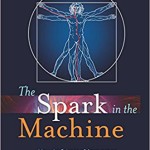 David Keown, an English medical doctor and acupuncturist, who tells the amazing story of how embryological development serves as the foundation of the acupuncture channels, and much much more. My fascination with embryology, thanks to Bonnie Bainbridge Cohen, has become a spiritual journey into the roots of creation itself as it manifests, here and now, in our embodied Presence.
David Keown, an English medical doctor and acupuncturist, who tells the amazing story of how embryological development serves as the foundation of the acupuncture channels, and much much more. My fascination with embryology, thanks to Bonnie Bainbridge Cohen, has become a spiritual journey into the roots of creation itself as it manifests, here and now, in our embodied Presence.
Translating into Western terminology, Jue Yin, the most anterior, is called the peritoneal cavity; Tai Yin is the anterior para-renal space, and Shao Yin is the retro-peritoneal space. For somanauts, these three spaces provide a way to differentiate the depth spaces of the body, the most challenging of the three spacial directions. Head to tail is simple with the three Dantiens the starting point. With side to side we have the innate bi-lateral symmetry of the human form, i.e., 2 eyes, ears, arms, lungs, legs etc. Front to back is challenging, especially in the upright posture, so we really have to slow down and allow the sensations and perceptions to come.
Frank Netter’s drawing of the a cross section at T-12 , similar to the one above, is viewed from below so you have to reverse left and right, but the cavities are the same. Notice the space behind the stomach, where Bonnie allows her ‘embryonic breathing’ to originate. Also, the liver, kidneys and spleen. These will be key areas in our explorations, as we track the flow of breath/qi, through the micro-thin spaces between two layers of fascia surrounding the volumes and the organs.
In Chinese Medicine, these Yin inter-fascial spaces or channels also have an upper (above the diaphragm) component, as seen above, and are linked to the lower through the three openings in the diaphragm. The Qi flows through these three ‘channels’. These channel also branch out into the limbs to complete the meridians associated with each organ system.
Jue Yin follows the opening for the Vena Cava and links Liver Acupuncture Channel with the Pericardium Acupuncture Channel. Tai Yin follows the esophageal opening, linking Lungs and Spleen/Pancreas; (embryologically speaking, the lungs emerge from a bud on the oesophagus near the vocal cords.), and Shao Yin follows the opening for the aorta linking Heart and Kidney channels.
Exploring the Jue Yin 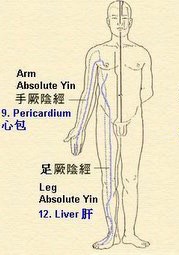
As an example, we see how the Jue Yin channel combines the Pericardium channel in the arm/upper body with the Liver Channel/leg in the lower body. ‘Absolute’ is one translation of the character ‘Jue’. Others are reversing or returning. Jue Yin runs from Liver-1 on the inside of the big toe all the way to Pericardium 9 at the tip of the middle finger. The pericardium channel also has an inner branch extending down the vena cava linking the three burners.
Dynamic Practice

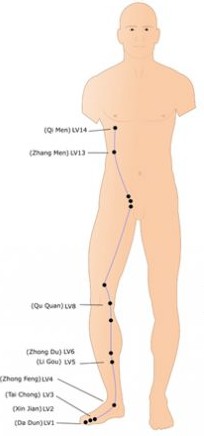 Setu Bandha Sarvangasana and its variations are great poses to explore Jue Yin. Activate the inner big toes and middle fingers to open whole meridian. For the ‘Leg Jue Yin’ Liver meridian, track flow from the inner big toes along the inner legs and knees and through the groins. (Right and Left) Upper and lower channels meet at the upper front diaphragm.
Setu Bandha Sarvangasana and its variations are great poses to explore Jue Yin. Activate the inner big toes and middle fingers to open whole meridian. For the ‘Leg Jue Yin’ Liver meridian, track flow from the inner big toes along the inner legs and knees and through the groins. (Right and Left) Upper and lower channels meet at the upper front diaphragm.
Feel the liver and pericardium rotating in opposite directions to open space for the vena cava. The Jue Yin channel is where yin has reached its maximum and begins to reverse or return to yang, like at the winter solstice. It is 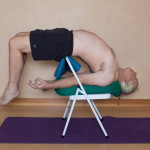 where the de-oxygenated venous blood is returned to the heart and lungs to be re-vitalized. Setu bandha is a more yin backbend allowing the yang to build gradually. As the Jue Yin channel opens, more challenging backbends can be added. This supported (yin) ‘sort of’ kapotasana is still more yang. Without support, backbends become even more yang. Open slowly.
where the de-oxygenated venous blood is returned to the heart and lungs to be re-vitalized. Setu bandha is a more yin backbend allowing the yang to build gradually. As the Jue Yin channel opens, more challenging backbends can be added. This supported (yin) ‘sort of’ kapotasana is still more yang. Without support, backbends become even more yang. Open slowly.
Another way to explore Jue Yin is through the forward bend 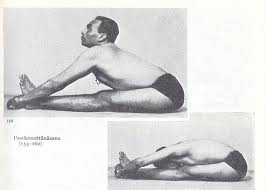 back bend flow mentioned in a previous post. In fact, you can explore the three yin “Great Channels’, by adding Tai Yin, (Lung and Spleen/Pancreas, the middle layer; and Shao Yin, Heart and Kidney, the inner most layer, anatomically speaking. Iyengar begins all his forward bends in ‘Light on Yoga’ by opening Jue Yin. The completed pose opens Shao Yin with the Tai Yin, the middle layer balancing the two.
back bend flow mentioned in a previous post. In fact, you can explore the three yin “Great Channels’, by adding Tai Yin, (Lung and Spleen/Pancreas, the middle layer; and Shao Yin, Heart and Kidney, the inner most layer, anatomically speaking. Iyengar begins all his forward bends in ‘Light on Yoga’ by opening Jue Yin. The completed pose opens Shao Yin with the Tai Yin, the middle layer balancing the two.
Most beginning yoga students collapse in at the Pericardium/Liver junction, and the compensate by over constricting the very outer layer, Tai Yang along the back body to stay upright. By aligning and opening the three inner or yin channels, both back bends and forward bends become organically beneficial.
Inner Practice
In meditative or restorative poses, allow your imagination/attention rest in the opening in the diaphragm for the vena cava as it passes from behind the liver up and into the heart. Bring compassion/Loving Kindness to your heart area so the Pericardium, the connective tissue surrounding the heart, also know as the ‘Heart Protector’, can relax a bit.
Allow you imagination attention follow the Jue Yin as it passes from the feet through the groins. Imagine where the common iliac veins converge to form the inferior vena cava. This is the area of the ‘Hara’. Rest and soften here, bringing Loving Kindness and Compassion. Allow the whole space from the bifurcation up to the heart soften and relax. This is the Middle Burner. Notice the inner link as the inferior vena cava links heart in the upper burner, IVC and aorta in the middle burner and below the navel lower burner. Add inner arms and legs.Have fun with wherever this qi takes you. Be Yin/receptive, allowing, not trying to control, as best you can. Be grateful for having a human body.
For more detailed work and multiple postures and sequences for Jue Yin, see Ruth Knill’s YouTube page. Ruth is a long time yoga practitioner and teacher as well as a licensed acupuncturist working in Arlington, MA. She is teaching a regular ‘Zoom’ yoga class on line every week.
Taosim/Chinese Medicine Background
 Foundational to all of Chinese Medicine is the Taoist non-dual principle of yin and yang, representing the three primary realities of creation: dynamism, inter-connectedness and change. The dynamic energy comes from the opposite polar charges of yin and yang. Although ‘opposite’ there is no ‘pure’ yin or yang; each is embedded in the other, no matter how deep you go. There is continuous flow between the two, one waxing, one waning, and then the reverse. What flows is known as qi, (or prana in Sanskrit).
Foundational to all of Chinese Medicine is the Taoist non-dual principle of yin and yang, representing the three primary realities of creation: dynamism, inter-connectedness and change. The dynamic energy comes from the opposite polar charges of yin and yang. Although ‘opposite’ there is no ‘pure’ yin or yang; each is embedded in the other, no matter how deep you go. There is continuous flow between the two, one waxing, one waning, and then the reverse. What flows is known as qi, (or prana in Sanskrit).
Chinese Medicine describes 12 Primary acupuncture channels, six yin and six yang, that regulate the flow of qi in the body. Each channel is associated with an ‘organ’ (more of a set of energetic processes than the physical organ of Western anatomy), and has points located along the surface of the body. However the channels also have branches that dive into the interior of the body.
In general, yang organs are hollow and move substances throughout the body. They are: (capitalized to differentiate them from the western anatomical organ) the Large Intestine, Small Intestine, Stomach, Bladder, Gall Bladder and a quirky one known as San Jiao, or Triple Warmer. There is no western equivalent, but the San Jiao balances the flow qi through the three burners, which we might see as a regulation of the whole digestive process An ancient Chinese medical text states: ‘The Upper Burner controls intake, the Middle Burner controls transformation, the Lower Burner controls elimination.’ It can also be seen as the mediator of tensegrity in the fluid/fascia living matrix. The San Jiao is a key for our heart/hara balance.
The yin organs include: the Heart (the most yang of the yin organs), Pericardium or Heart Protector, Lungs, Spleen/Pancreas, Liver and Kidneys (the most yin of the yin organs.
One way to group the 12 Primary Channels is in yin/yang pairs of 2, giving us the 6 Great Channels. The six pairs link yang upper body/arms with yin lower body legs. There are three arm yang channels linking with three leg yang channels, and three arm yin channels linking with three leg yin ones. The Great Channels actually arise from 6 embryological, fascially distinct cavities that are arranged spatially from the yang, Governing Vessel back body to yin Conception Vessel front body, in this order:
Tai Yang – Yang Ming – Shao Yang – Shao Yin – Tai Yin – Jue Yin
These also determine a flow with Tai Yang being the Beginning of a cycle and Jue Yin the end of the cycle, which is why Jue Yin is called returning or reversing Yin where
Thank you and credits to Frank Netter for his anatomical drawings
and Marc Ignacio on Upsplash for his candle photo.
As always, questions on practice and editorial and copy editing corrections greatly appreciated.
